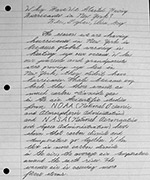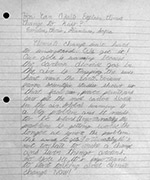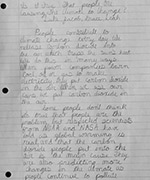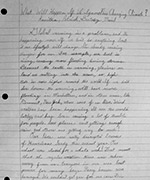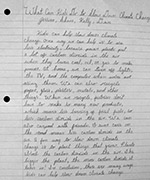Talking to Children about Climate Change
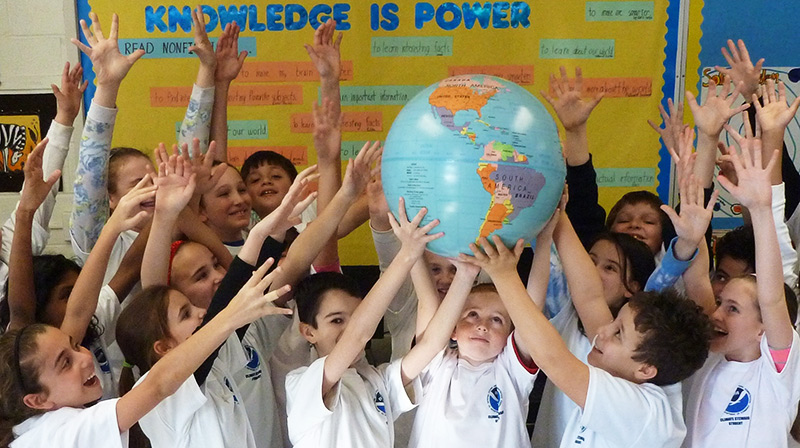
Kottie Christie-Blick is a teacher at Cottage Lane Elementary School in the South Orangetown Central School District, in Blauvelt, New York. She's also an educational consultant. Kottie has published articles in several educational journals, and has presented at educational conferences across the United States and in several other countries. She's a NOAA Planet Stewards Educator and a Distinguished Fulbright Teacher.
The musical alert jolts me awake before I ease back into a grateful calm reading the words on my phone. All schools in the district are on a two-hour delay. I now have extra time on this icy morning to correct that stack of essays on climate change before heading off to teach my 5th grade class. It will take that long for the snowplows to finish clearing the roads.
Climate change – global warming – a curious topic to be thinking about on such a frigid morning? Not at all. The scientific evidence is in. No matter what local weather we're experiencing on a day-to-day basis, our planet is warming up, with far-reaching implications for us all. The conversation in scientific circles now is how Earth will respond, how well the living things on Earth will be able to adapt, who will be the winners and the losers, and what we can do to slow down our warming climate.
"Why Have We Started Having Fiercer Hurricanes in New York?"
essay written by Ben, Dylan, Elisa, Greg.
The reason we are having fiercer hurricanes in New York is because global warming is heating up our oceans. When our parents and grandparents were growing up here in New York, they didn't have such hurricanes. That's because way back then there wasn't as much carbon dioxide gas in the air. Scientific studies from NOAA (National Oceanic and Atmospheric Administration) and NASA (National Aeronautics and Space Administration) have shown that carbon dioxide and temperature go together. When there is more carbon dioxide in the air, the average air temperature around the earth rises. This warm air warms our oceans. This causes more water to evaporate, which forms lots of warm, moist air. This is the kind of air that hurricanes need to start up, and they need a steady supply of it to keep them going. Our warmer ocean this year and last kept the hurricanes alive all the way up the coast to New York! We must slow down climate change. It's fueling hurricanes like Hurricane Sandy and Hurricane Irene.
Some think of climate change as a topic for grown-ups. However, even young children are able to understand the basic idea. More importantly, they're able to begin taking action to slow down global warming. It's in their best interest to do so. Their future depends on the actions we all take now. If we teachers, and their parents, don't tell them the truth, and don't point the way toward a positive future, who will?
"Is Climate Change too Scary for Kids?"
essay written by Christian, Isaiah, Shay, Lauren.
Climate change is not too scary for kids, but it is a problem. Climate change is happening now. We've started to see some changes on our planet. We understand if we don't slow down global warming, bigger changes could come. That would be scary. We don't want areas near the ocean to flood because we have friends and family living there. We don't want innocent animals to lose their habitats. However, we've learned we can help slow down global warming, and the changes it's causing, by putting less carbon dioxide in the air. That's why climate change isn't scary for kids. When kids understand cause and effect they know what to do. It just makes sense!
When talking with children about climate change, match the depth of conversation to the child's age. Keep it honest. Children want to know the truth. They want to understand this world they're living in without being overwhelmed by too much information. Explain the difference between day-to-day weather and "climate," the average weather over a long period of time (a decade or more). Read a children's book about climate change together. Assign pairs of students to read and discuss newspaper articles on climate. Watch a YouTube video together about the difference between weather and climate, and how to use a graph to predict future climate. Visit the Environmental Protection Agency's website for the background basics of climate change. For more advanced information, see the National Oceanic and Atmospheric Administration's website, Climate.gov. You may have to translate sophisticated language, but your students will benefit by seeing the graphics, and you'll be given accurate information. In addition, older children will benefit by hearing such terms as mean, trend, and evidence, in real world contexts.
"How Can Adults Explain Climate Change to Kids?"
essay written by Emilia, Chris, Gianluca, Sofia
Climate change isn't hard to understand. We get it! Our globe is warming because the carbon dioxide gas in the air is trapping the sun's heat near the Earth. Evidence from scientific studies shows us that factories, power plants, and cars put the most carbon dioxide in the air. Global warming is a big problem and it needs to be solved. Unfortunately the problem is getting worse. The longer we ignore the problem the worse it gets. Fortunately, it's not too late to make a change and turn things around. So you see, it's important to start talking about climate change NOW!
Complicated topics such as The Greenhouse Gas Effect, which describes why Earth is warming, can be explained at different levels, from basic understanding to complicated chemical equations. The important part is that children understand that some gases, such as carbon dioxide, trap the sun's warmth near the earth. We need some of this warmth to sustain life on this planet, so some carbon dioxide in the atmosphere is a good thing. However, the more carbon dioxide in the air, the warmer the planet becomes. Our quality of life depends on having fairly predictable weather and a livable climate. Adding more carbon dioxide to the air threatens that, because the additional warmth it causes upsets the balance of natural systems. Older children will appreciate the scientific evidence for climate change. In the short term (the past 200 years), it's clear to see that the increased carbon dioxide in the air from factories, power plants, and cars has caused our planet to warm. For the older child, looking farther back in time (thousands, or even millions of years), it's interesting to look at the fossil evidence of climate shifts. Note that the shifting takes place over thousands of years, not the short time scale we're seeing now since the Industrial Revolution.
"Is It True That People Are Causing the Climate to Change?"
essay written by Luke, Jacob, Grace, Leah
People contribute to climate change every day. We release carbon dioxide into the air, which traps the sun's heat. We do this in many ways. When power companies burn coal, oil or gas to make electricity, they put carbon dioxide in the air. When we use our cars, we put carbon dioxide in the air.
Some people don't think it's true that people are the problem, but respected scientists from NOAA and NASA have told us global warming is real, and that the carbon dioxide people put into the air is the main cause. They are also predicting more changes in the climate as people continue to pollute the air.
Scientists have equipment that measures how much carbon dioxide is in the air. They also look at carbon dioxide bubbles that have been trapped in ice for thousands of years to understand what the climate was like a long time ago. They compare climates over time. We've seen the graphs.
Their evidence shows that most of the carbon dioxide put into the atmosphere is caused by people, and as the carbon dioxide increases, the Earth's temperature increases. As you can see, people are contributing to climate change. We know it's true because respected scientists have shown us the evidence.
To expose your children to first hand evidence, take them to a local science museum. Look for displays showing scientific evidence of Earth's climate, thousands, or even millions, of years ago: pollen grains in sediment cores, fossils, signs of changing sea level, etc. Contact a science department at your local university: geology, oceanography, atmospheric sciences, or environmental sciences. See if they give tours. Invite a scientist who specializes in paleoclimate to your classroom. Ask her to bring physical evidence, and a slide show of evidence-gathering in the field. What a life-changing experience it can be to engage with a real scientist, and hold fossils that are millions of years old that contain evidence of climate change.
"What Will Happen If We Ignore This Changing Climate?"
essay written by Kavitha, Patrick, Bartosz, Mariel
Global warming is a problem, and it's happening now. If we don't do anything about it our lifestyles will change. It's already causing changes for us. For example, sea level is rising, causing more flooding during storms. Because the Earth is warming, glaciers on land are melting into the ocean, so high tide is now higher around the world. If we don't slow down the warming, we'll have more flooding in Manhattan, and in other areas, like Piermont, New York, where some of us live. Weird weather has been happening all over the world lately, and has been causing a lot of trouble for people. Some places aren't getting enough rain and others are getting way too much!
Our lives were really disrupted because of Hurricane Sandy this school year. Our school was closed for a whole week! That meant that the regular vacation time was taken away from us. Everyone in our area lost power for many days. Many houses were damaged. We couldn't get gas for our cars. This may not happen again every year, but there's no denying the evidence that our weather is becoming more extreme in New York, and in other areas. As you can see, if we ignore global warming our lifestyles will change.
Once children understand the difference between weather and climate, and the cause and effect between carbon dioxide in the atmosphere and global warming, they'll want to know why it matters. It's all about keeping our earth in balance to maintain our quality of life.
Classroom conversations can empower them. As with all of the other scary things in life we need to discuss with our children, such as stranger danger, they can handle it if they understand they have some control over the situation. It's encouraging for them to know that they're not alone. There are actions people are taking now to reduce the amount of carbon dioxide going into the air. And they can too, even if they're just kids. As our words turn into actions we become part of something bigger, something important. Even very young children can begin learning that we need to take care of Planet Earth, even if they don't yet fully understand why.
"What Can Kids Do to Slow Down Climate Change?"
essay written by Jessica, Shane, Kelly, Dan
Kids can help slow down climate change. One way we can help is to use less electricity, because power plants put a lot of carbon dioxide in the air when they burn coal, oil, or gas to make power. At home, we can turn off lights, the TV, and the computer when we're not using them. We can also recycle paper, glass, plastics, metals, and other things. When we recycle, factories don't have to make so many new products, which means less burning of fossil fuels, so less carbon dioxide in the air. We can also carpool with friends. Fewer cars on the road means less carbon dioxide in the air. A fun way to slow down climate change is to plant things that grow. Plants absorb the carbon dioxide in the air. The bigger the plant, the more carbon dioxide it takes in! In conclusion, there are many ways kids can help slow down climate change.
Our educational system is beginning to understand the responsibility and power we teachers have to move society forward. The Next Generation Science Standards (NGSS) directs us to teach Earth's Systems, and ways in which people affect these systems. The Common Core State Standards for English Language Arts that requires the reading and analysis of nonfictional texts, and the writing of expository essays, provides opportunities for students to use their emerging skills to understand a concept that's important to them. The Common Core State Standards for Math mandates that students spend class time analyzing data, and using graphs to recognize patterns in order to predict the future. When your students put the Common Core to good use to understand important concepts that affect their lives, you'll come to appreciate the accelerated academic rigor of these new standards, and your important role in influencing society's priorities.
Additionally, there are programs for teachers to learn more about climate change. As a Climate Stewards Educator, I receive free information from the National Oceanic and Atmospheric Administration. NOAA also provides opportunities to participate in webinars, field trips, and collaborative projects with other Planet Stewards. This year, my students participated in "live lessons" with a class of 5th graders in South Africa, discussing climate change. The Fulbright Distinguished Awards in Teaching Program provides teachers the opportunity to work on significant academic issues, such as teaching climate change, in a foreign country. During the 2011-12 academic year, I worked in South Africa researching environmental issues, consulting in the schools, and sharing the information with my school back in New York. When our students understand that children and adults in other countries are also helping the environment, they understand that positive change is possible.
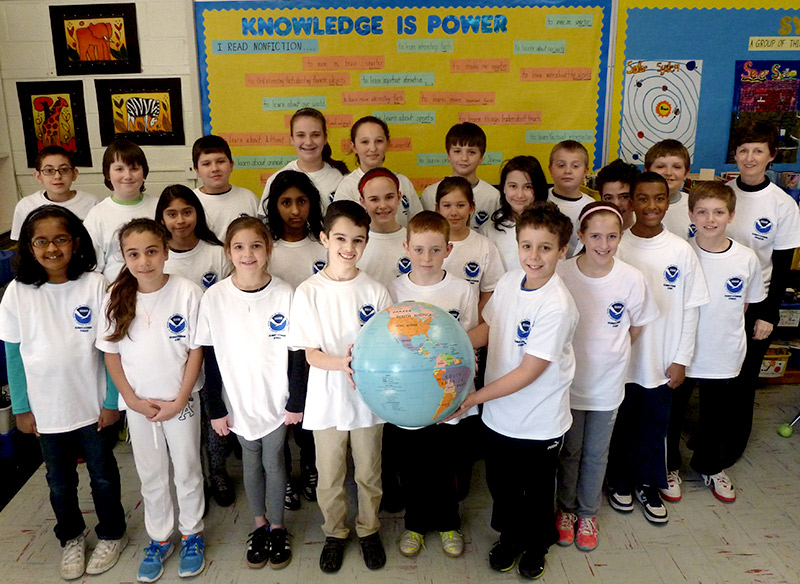
Kottie Christie-Blick and 5th Grade Students.
Don't worry about not knowing all the facts at first. Plunge in by visiting the links in this article. They'll lead you to other informative sites. The important thing is to start talking about our changing climate, and to begin modeling ways we can help slow down climate change. The quality of our children's lives, and THEIR children's lives, depends on the actions we take today.
The two-hour gift of time all too quickly consumed, I head off to school. I think about my students' essays, the children's questions and concerns, their enthusiastic discussion yesterday about what they want to be when they grow up. The car radio diverts my attention. 2015 was the warmest year on record for the contiguous United States. Time to start teaching.
Click here to read this article on Ms. Christie-Blick's Class web site, see related videos and find out about other projects she is involved in.
Education
Webinar Archives Education ResourcesStewardship
Supporting Stewardship Past Projects Focus Area Resources Applying for Funding
Search Education
Get Social
Last updated: 06/16/24
Author: NOAA
How to cite this article
